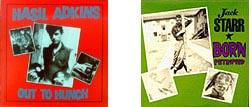« February 2005 | Main | April 2005 »
March 20, 2005
07. Banality (Experimental Jetset)
Regarding the culturally pessimistic notion of the banalisation of graphic design: When opening up the Van Dale Dutch dictionary to look up the exact meaning of the word 'banal', we find 'hinderlijk alledaags', which roughly translates as 'disturbingly commonplace' ó a beautiful, almost paradoxical definition. Two words put together, creating a tension which is almost electric. Now reconsider the notion of banal design, and imagine an object which is widely used, commonly accepted, but still has the ability to disturb. An object that has the potential to become part of society, but not to dissolve in it completely. In short, an object that relates to reality in a truly dialectical way. The banalisation of graphic design? We should be so lucky.
[From 'Lazy Sunday Afterthoughts: A collection of random notes by Experimental Jetset (in alphabetical order)", in Dot Dot Dot 7, page 79]
Posted by Luke Wood at 11:35 AM
March 14, 2005
Future imperfect
This is the final 'bit' in Rick Poyner's book "Obey The Giant: Life in the Image World". I'm interested in his distinction between knowing imperfection (Fella and Keedy's 'anti-mastery') and what he defines loosely as 'flawed mastery' or 'imperfect design'. This distinction isn't exactly well articulated ñ it's a short piece ñ he doesn't mean by this "some kind of camp or ironic 'so bad it's good'". . . nor does he mean "design so lacking in saving graces that not even the most dedicated ironist could tease any humour from it." Anyhow, I liked the way he ended, and it felt like my topic . . .
"Designers who allow space for the peculiar, the wayward, the imperfect ñ and, sometimes, the just plain 'wrong' ñ set in motion a process and create the conditions for the viewer to have truly unexpected encounters with design that are one of its keenest, most human pleasures and a large part of its point."
Posted by Luke Wood at 10:16 AM | TrackBack
March 08, 2005
History as cumulative
In 'Dot Dot Dot 7', Peter Bilak looks at Mevis & van Deursen's typeface (2003) for the Boijmans van Beuningen Museum, and their appropriation of the typeface designed by Lance Wyman for the Olympic Games in Mexico in 1968. Formally similar - differences in content, time and context, mean "there is a great difference in the final effect of the project." Bilak states that MvD's type stands at a DISTANCE from it's subject matter, "fragmenting the fonts into seperate layers and using them in unexpected ways".
"The project understands history as a dynamic, non-linear process where now and then coexist." Following the text I wrote for ProDesign, I've been thinking about the idea I put forward there where one returns to the past to find a new trajectory 'out' from it again. Could MvD's project be an example of this? In terms of my own enquiry I certainly conceive of history as being non-linear. Anna Gerber mentions this too in her defense of the mistake/accident through history in 'All Messed Up'.
Most interesting is Bilak's reference to Jorge Luis Borges's story 'Pierre Menard, Author of "Don Quixote"', where Borges's character Menard painstakingly rewrites Cervantes's entire book resulting in an almost identical text. When comparing the 2 books Borges claims Menard's rewriting as "infinitely richer". Why? Because it was written hundreds of years after Cervantes, because of it's new associations, and because it RENDERS HISTORY AS CUMULATIVE, including all contemporary references that Cervantes could not have included.
Posted by Luke Wood at 12:33 PM
March 04, 2005
Hasil Adkins and Jack Starr
Hasil Adkins was the best thing that happened to me in our trip to the States. Actually it was kind of weird cause I brought this record in LA on literally our first day in America, but I couldn't listen to it because I never had access to a turntable. So I pretty much brought it because of the photos of Hasil and the text on the back (describing his recording methodologies and the subject matter of his songs . . . cutting off his girlfriend's head so she "cain't eat no mooore hot dawgs"). Listening to it when I finally got back was like a relgious experience for me. Having an idea in your head for a while about this 'thing' that might exist and then finding it . . . I have seen the light!
Hasil Adkins is THE MAD SCIENTIST. He makes MONSTERS. The process and the artefact always reside on the verge of being out of CONTROL. Within the very familiar formula that was 1950s rock'n'roll (rockabilly) Adkins creates RISK and DANGER. "Out to Hunch" also reminded me of Lisa's questioning of my need to 'finish' things and what that might mean. Cameron also suggested that what was actually interesting about monsters was that they were unfinished, incomplete. Hasil's songs never feel finished or complete . . . they exist more like sketches, as evidence or as outcomes of exploration.
In my last seminar I talked briefly about the hybrid nature of rockabilly music and related it to my interest in creating 'monsters' (of a kind). I then discovered the Cramps album "How to Make a Monster" which also draws the same connection. Jack Starr (like Adkins, and on the same label, Norton Records) actually lives/acts out this connection. Starr actually wants to BE THE MONSTER, the cover of this album "Born Petrified" features old b/w photographs of Starr wearing monster masks and outfits. Starr was infatuated with monster flicks of the time and set about to make his own, creating his own costumes and, of course, soundtracks.
Posted by Luke Wood at 02:19 PM
